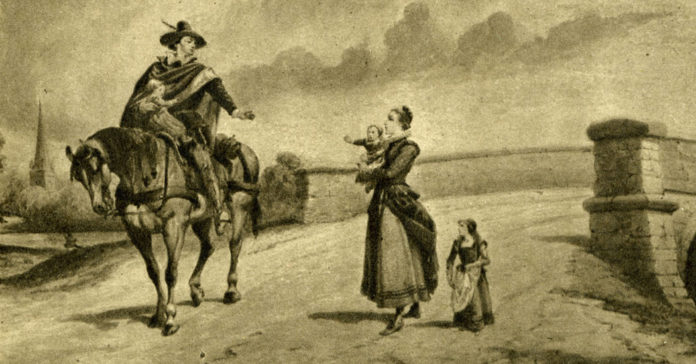
“Neither a literary biography nor a full biography,” this book looks more narrowly at what surviving documents tell us, and, when their trail runs dry, what documents about his neighbors might reveal about events that defined Shakespeare’s Stratford life: his father’s financial collapse, his marriage, his homes (including the “Birthplace,” likely damaged by fire in the 1590s, then rebuilt), his will and his memorial. Though most of it consists of dense scholarly analysis, it reads like a detective story in which a skilled investigator returns to a cold case.
It amounts to a revisionist portrait of the artist. The transgressive image of Shakespeare circulating in recent years — cosmopolitan, perhaps secretly Catholic, most likely gay or bisexual, eager to flee Stratford — is replaced here by a Shakespeare who is “a family man” in a close economic partnership with his wife. He is especially devoted to his father, whose fall from the height of Stratford’s leadership to a man who was afraid to leave his house for fear of arrest for debt was, for Orlin, “the defining event” of Shakespeare’s private life, from which “all else followed.” She interprets Shakespeare’s marriage at a young age (which would have brought to an end any apprenticeship and precluded as well a university education) as an act that helped restore his family’s fortunes. Most scholars have read Shakespeare’s last will and testament as at best chilly, especially when it came to his family. But Orlin sees it otherwise. While it was not, like many Jacobean wills, an “expressive” one, she shows how each gift that Shakespeare specifies, including apparel, sword, bowl and that notorious bed, shares “the imprint of an unnamed grief.”
She also shows that much of what we take as fact about Shakespeare’s life hangs by the slenderest of archival threads. Anne Hathaway’s baptismal record does not survive, and the only reason for believing she was eight years older than Shakespeare is the number that appears on her memorial brass — often enough, Orlin shows, imprecisely remembered or rendered. In her assiduous research Orlin came upon a baptismal record from 1566 for a Johanna Hathaway, daughter (as Shakespeare’s wife was) to a Richard Hathaway of Shottery. Orlin doesn’t push this possibility too hard, but if this was the woman Shakespeare married — her first name inaccurately transcribed — Anne might have been two years younger than her husband.
Three contemporary images of Shakespeare are widely accepted as authoritative. One is the awkwardly executed woodcut that appears in the 1623 First Folio. Another is the romantic Chandos portrait now in the National Portrait Gallery. These two are endlessly reproduced. Not the third, an effigy in painted limestone in Stratford’s Holy Trinity Church, in which Shakespeare looks like — as the scholar John Dover Wilson put it — a “self-satisfied pork butcher.” Orlin’s account of this monument is definitive. She sends packing the “authorship skeptics” for whom a conspiratorial cover-up accounts for the differences between 17th-century sketches of this memorial and the frequently repaired and looted effigy (from which the actor David Garrick reputedly stole the “right forefinger”). She goes on to suggest that Shakespeare likely commissioned the effigy and had met Nicholas Johnson, the artist who made it. If so, like it or not, this is how Shakespeare wanted to be remembered. Her account, detailed and dazzling, also left me melancholy, for all too soon, given cutbacks in funding and training, this kind of scholarship may no longer be possible.
Shakespeare biography is often marked by overreach, and Orlin is not immune. An academic herself, she can’t help recasting Shakespeare as one, urging us to “picture Shakespeare participating in the intellectual culture of Oxford” and asserting that “Shakespeare is nearly certain to have taken in lectures and sermons in college chapels.” There is no hard evidence given for these claims. And having argued that Shakespeare had a study in New Place, the large house he purchased in Stratford, she can’t resist fantasizing that this is where he wrote his late plays: “How many of his characters and episodes developed out of the scenes that unfolded on the streets below him as he wrote in the western light of the study window?” Her source? The gossip-hunting vicar of Stratford from the early 1660s, John Ward. Orlin’s meticulous handling of archival material fails her here, as her eagerness to encroach upon the London Shakespeare upends her usual accuracy. Ward never wrote that Shakespeare “in his elder days lived at Stratford, and supplied the stage with two plays every year.” He in fact jotted down two separate anecdotes, which Orlin then combines, linking them with a comma (those who are curious can consult a facsimile at the Folger Shakespeare Library’s site, “Shakespeare Documented”). Orlin knows that late in his career Shakespeare collaborated with other dramatists, working with John Fletcher on his last three: “Henry VIII,” “The Two Noble Kinsmen” and the lost “Cardenio.” You don’t write plays with co-authors who live a three days’ ride away. These are unfortunate missteps in an otherwise impressive and valuable book, a biography that will lead many to revise their classroom lectures.







